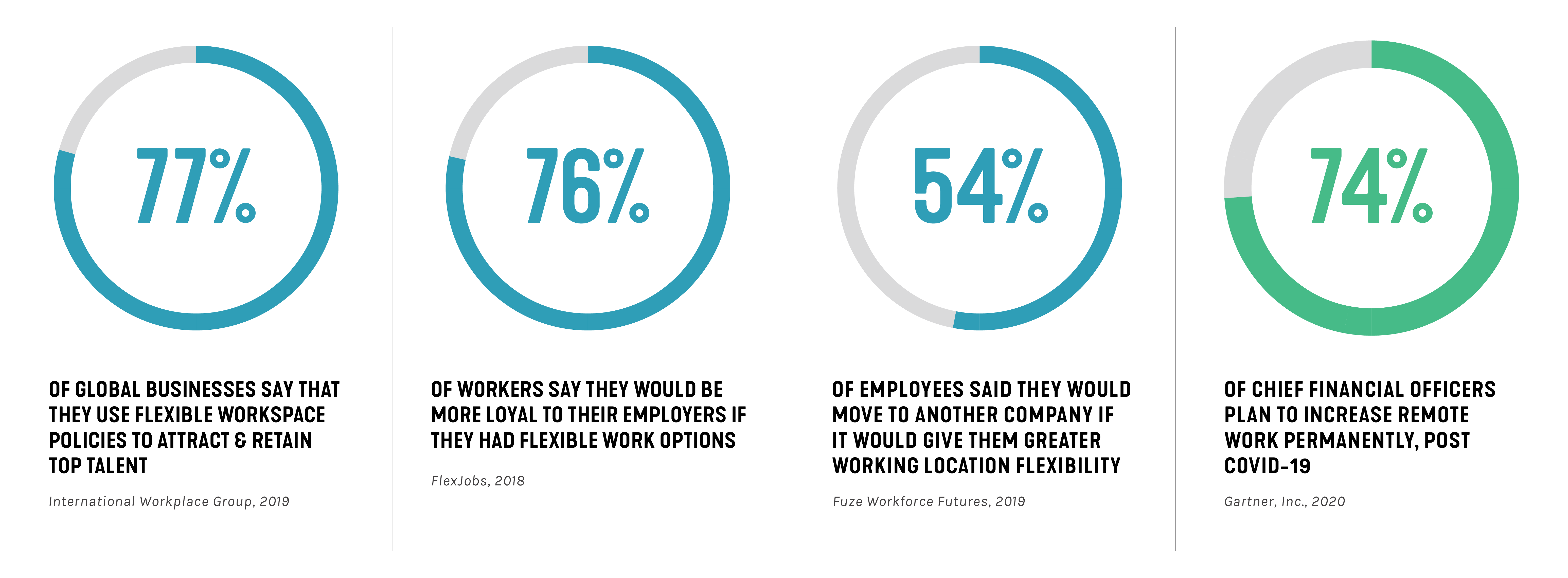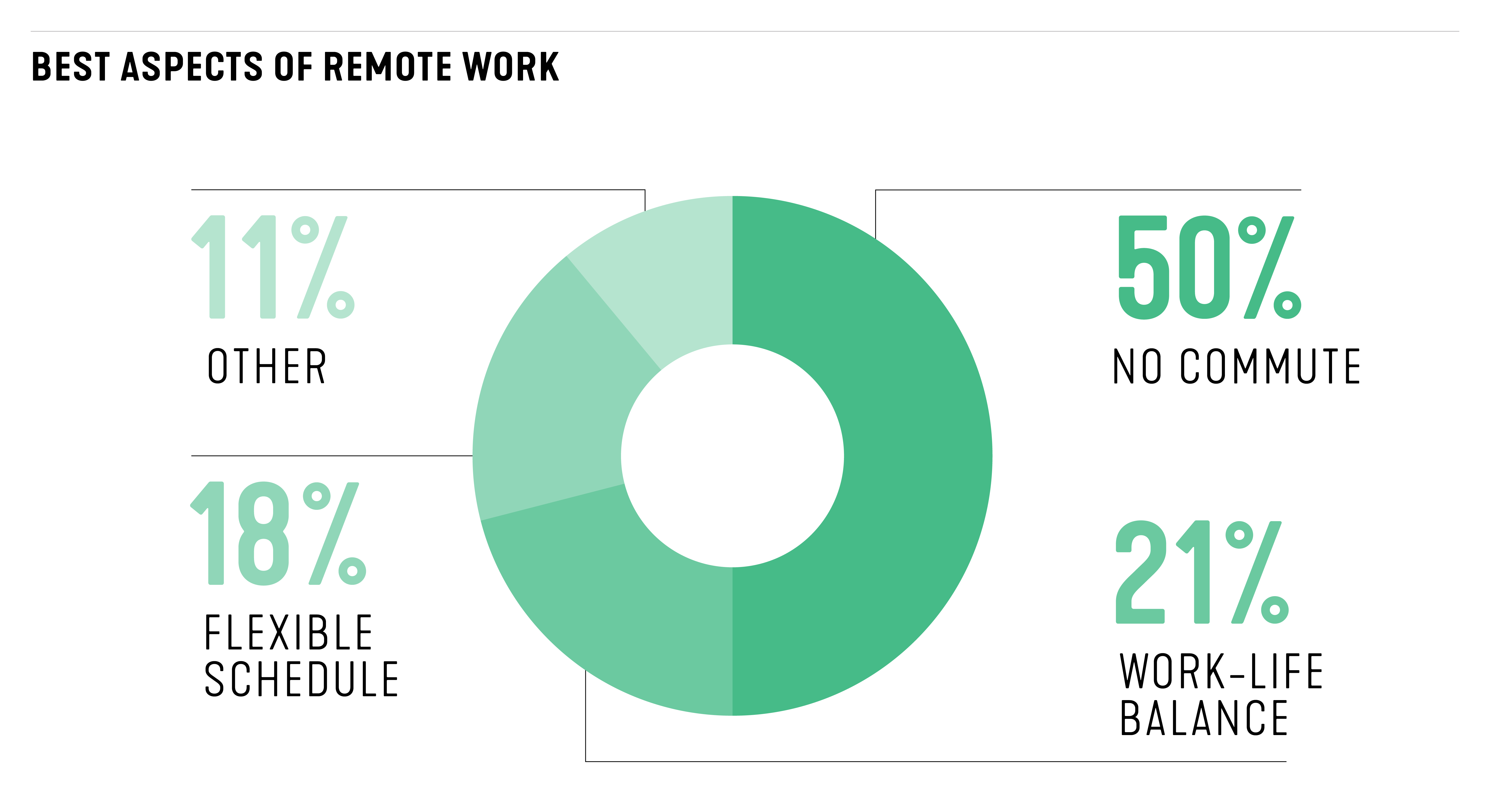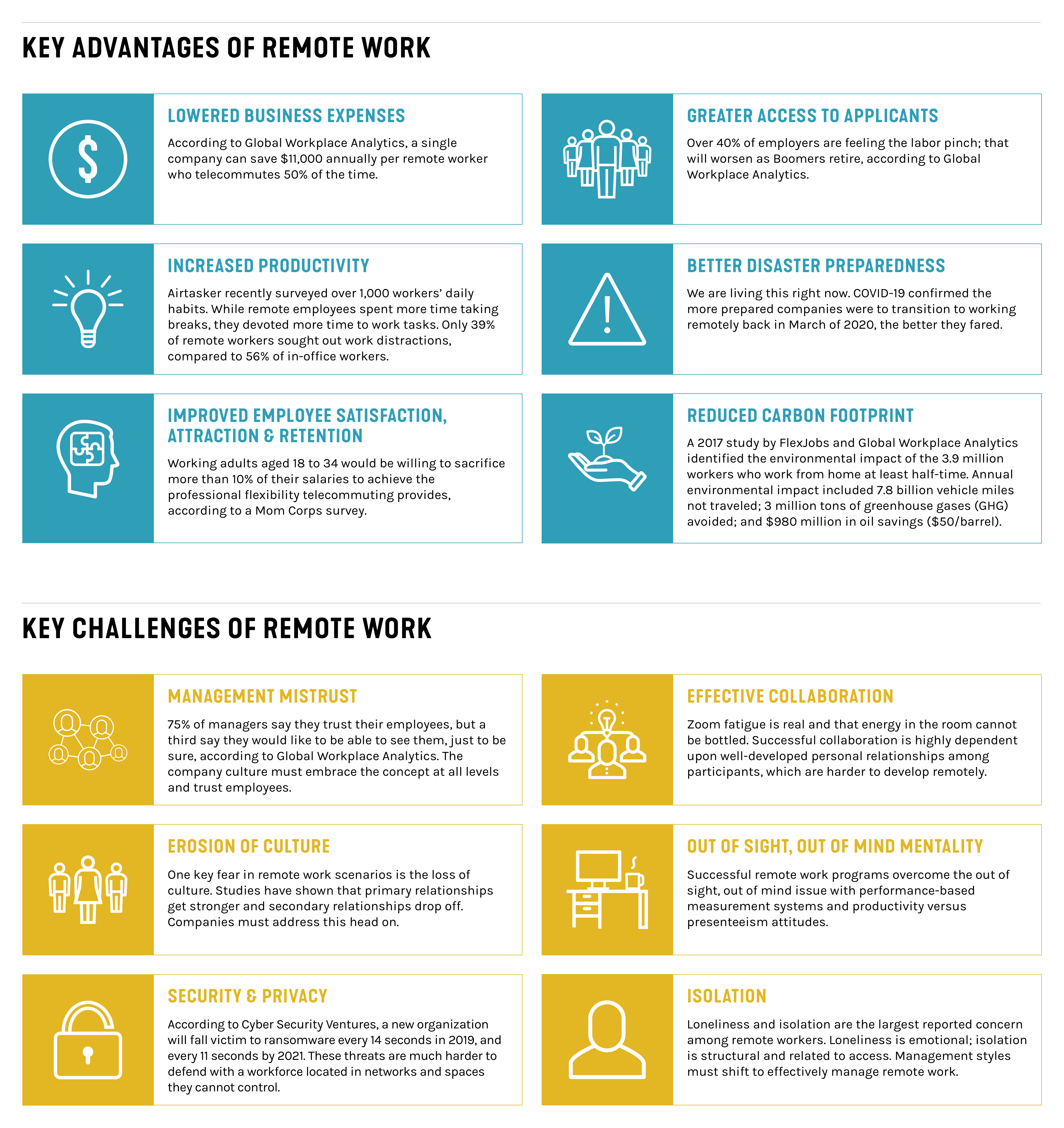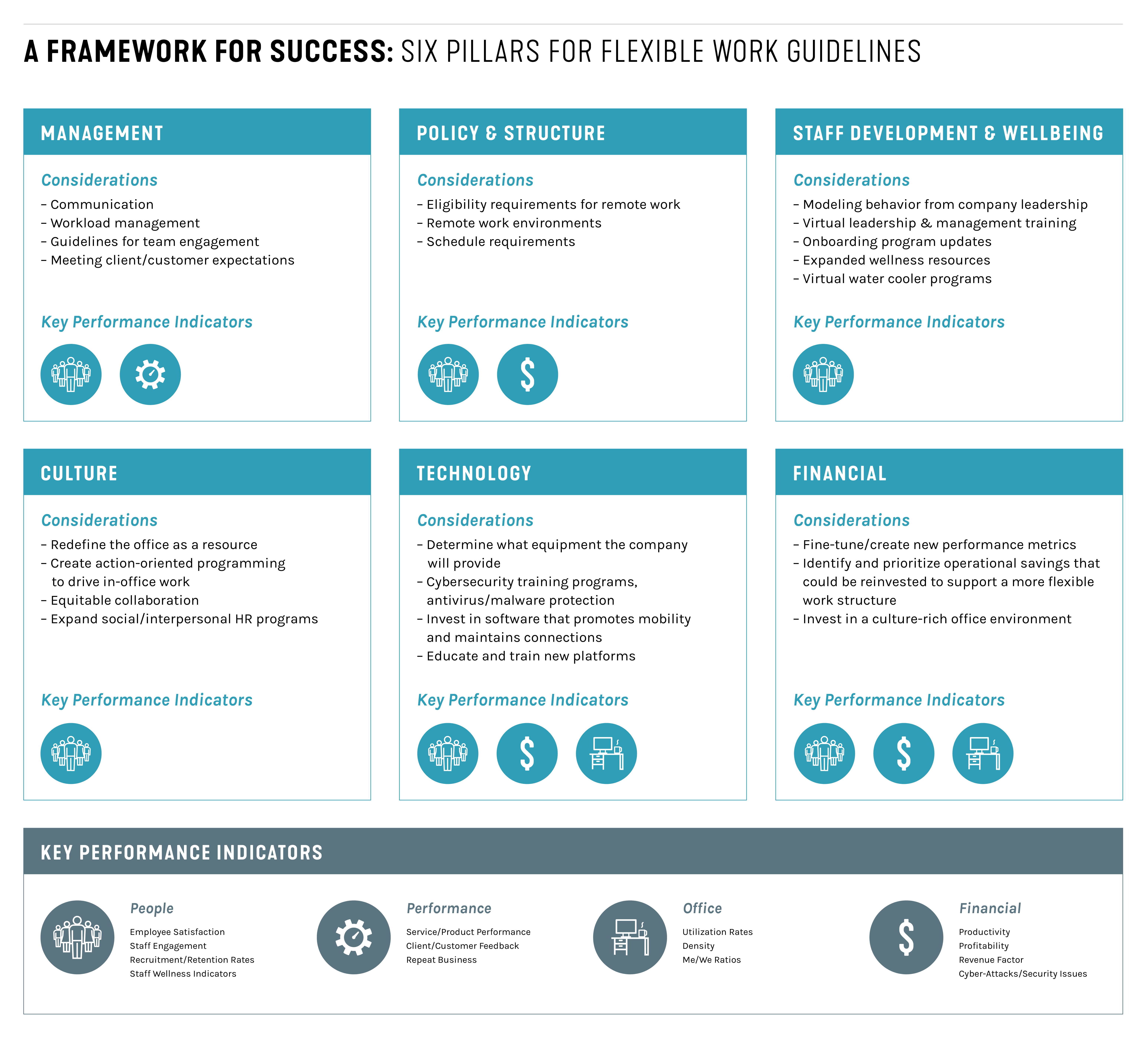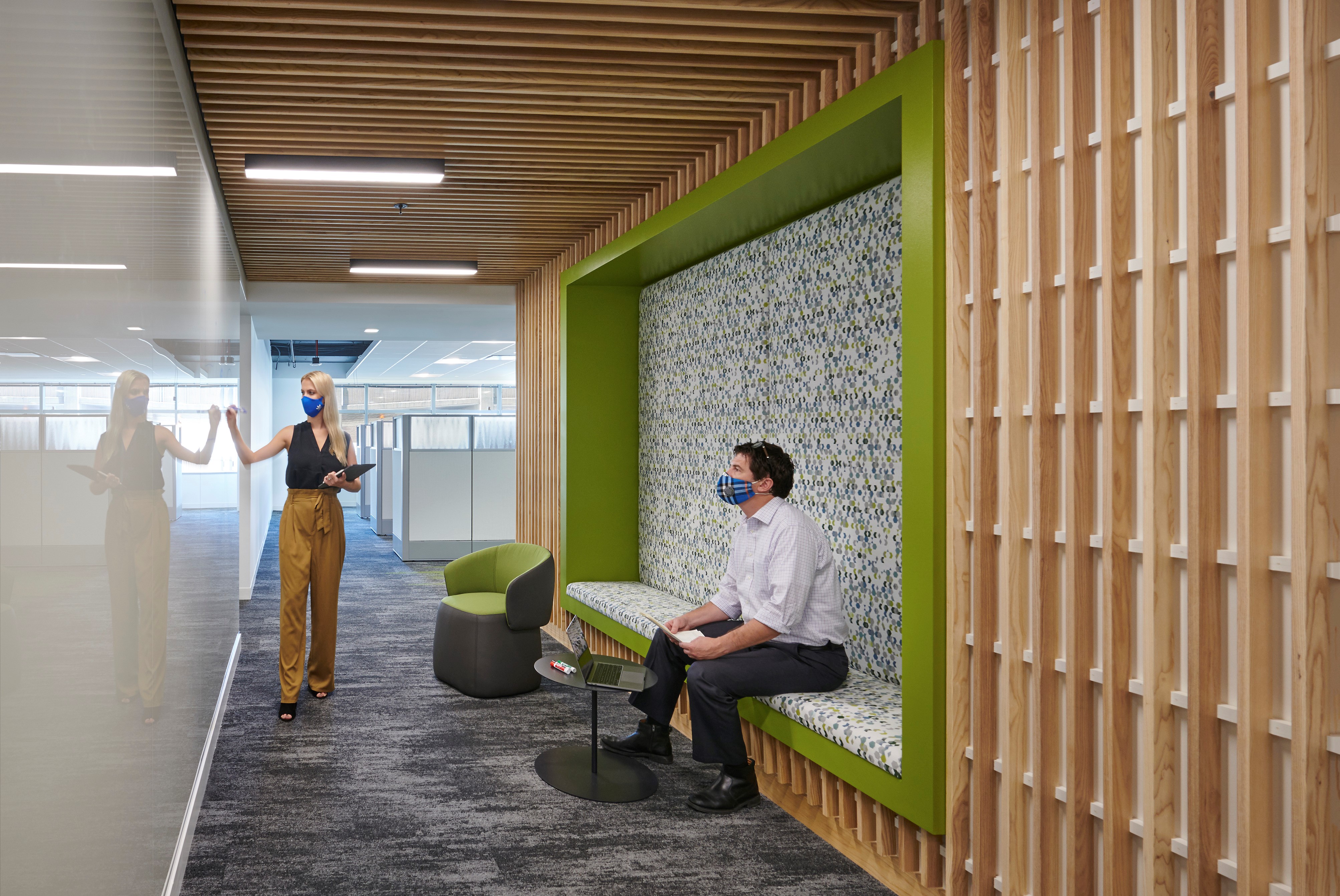Flexibility is Key in the Future of Work
Though it began as an unplanned experiment tested under highly unusual circumstances, the knowledge-worker’s recent and extended foray into the world of remote work has ignited an honest and in-depth exploration into the role physical office spaces play within an organization, the level of flexibility that employees expect from their employers, and what companies are willing to embrace moving forward. This is just the beginning in what will likely become a widespread paradigm shift in workstyles and modalities across industries. And the commercial real estate industry and organizations around the world are trying to discern how this new era of work will impact performance, profitability, operations, real estate, and future space requirements. To put it simply, the future is flexible.
Employees Crave Flexibility
Employees have been vying for more flexible work policies prior to the global pandemic. A quick review of the statistics shown above confirm that talent – or people, which are undeniably a company’s biggest asset – want more flexibility. Quarantine, shelter-in-place, and physical distancing over the last several months have given people a chance to reflect on what parts of their daily lives they miss and which they can do without. Some feel empowered with more autonomy over their time; others feel isolated, not getting the direction or interaction they crave from time spent at the office. According to a recent study by Collier’s, most people want to keep a little of both worlds, with 70% of employees reporting that after the COVID-19 pandemic subsides they still expect to work from home at least one day a week.
SmithGroup strategists have been working with clients across markets and geographies to redefine their own future of work. This process has included surveys from over 2,200 workers across the country. Key insights emerged from these surveys:
- When ranking the best aspects of working from home, respondents’ site the following: 1) no commute, 2) work-life balance, and 3) flexible schedules.
- When ranking the challenges associated with working from home, the results were much more varied:
- A university administrative client cited that challenges centered around the people: 1) integrating new team members, 2) maintaining company/team culture, and 3) reduced team cohesiveness.
- A professional service firm reported 1) missing conversations with colleagues, 2) too many meetings, and 3) feeling isolated.
- A public service consulting and operations division of a medical school offered challenges that were much more tactical: 1) lack of ergonomic seating, 2) network connectivity/VPN issues; and 3) computer/laptop quality.
Just as people take stock of their personal lives and adjust to new routines and ways of working, companies are doing the same. Commercial office space has been underutilized for years, with only half of individual workspace occupied, on average, at any given time. This led to an increase in agile working environments and mobility strategies over the last decade. SmithGroup’s own use of office space aligns with this finding, averaging 50% utilization rates pre-pandemic. Whether driven by finances or when the opportunity to reimagine and optimize is presented, companies will reconsider investing in grossly underutilized real estate for the long haul.
That said, humans thrive on relationships and the social connections that occur in shared physical space. Though many individuals have been surprised by their effectiveness working from home, there are a myriad of reasons employers and employees alike want to return to the office. The unavoidable ingredient on both sides? Flexibility. Companies need to create a workplace ecosystem that enables and empowers staff at all levels to navigate how and where work-related activities are accomplished. Additionally, employees must become keenly aware of the environments that foster the greatest productivity, creativity, and collaboration in their own work life. Is it possible to create a flexible, blended environment where both in-office and remote work can harmoniously co-exist? Can the reductions in real estate costs be reinvested in people, experience, and technology? If so, what guidelines must be created to capitalize on key advantages while minimizing key concerns?
CREATING A HYBRID WORK MODEL
At SmithGroup, we embrace opportunities to work alongside clients who push boundaries and share our brand promise: to Design a Better Future. We have spent the last several months working with clients across the country to reimagine the future of work. While we cannot predict when our world will return to somewhat normal operations, savvy business leaders in multiple market sectors are leveraging this time to set their organizations up for success when that new normal does arrive. This is not a one size fits all scenario. What adjustments will (or will not) align with your firm’s mission, vision, values, and culture while also helping your company reach its business goals? Companies should also consider the following components when developing a flexible, blended environment with a mix of in-office and remote work:
IMPACTS OF OFFICE DESIGN
No one knows what the future entails, making it much harder to make decisions when it comes to assessing changes to one's physical office. Clients are hesitant to quickly abandon their strategic workplace guidelines/standards/templates that were carefully developed over time, for a solution driven by what may be a fleeting moment. Will the ways of work simply flip back to pre-pandemic modes years down the road? While we certainly don’t have a crystal ball, our strategists and designers don’t think so. The notion of returning to business as usual would mean a missed the opportunity to learn from the advantages and challenges we’ve seen over the last several months.
We believe the solution evolves around flexibility. Workplaces must be able to easily accommodate temporary restrictions in the future. Flexible furniture solutions, adjustable floor plans and circulation paths, multi-use spaces that can be tweaked at a moment’s notice, and other flexible solutions will be critical components to a successful design. For existing spaces, business leaders and building owners could consider layering on various improvements or components via pilot projects. Deploying new solutions as experiments that can be tweaked with feedback will go a long way with employees. For instance, one global technology company wants their offices to be viewed as sleek and elite -- reminiscent of the latest space one would need a membership to access. Modeled after a private gym or social club in this organization's mind, their physical office is far more than a resource -- its a coveted benefit. This is the time to test solutions, gather feedback, make necessary changes, adopt, assess and then repeat. Create next-level engagement with staff to kick-start a new office culture, post-pandemic.
When considering environments for the next future future of work, it is also critical to consider the impact physical spaces have on people and their wellbeing. Advancing and increasingly accessible science provides a key to unlock the potential in an organization’s most valuable asset: its people. We understand and can now quantify human impacts derived from access to daylight and views, fresh air and high-quality food. Ensuring this science is represented in new design strategies poses a great opportunity to increase engagement and creativity at a time when people need it most.
SmithGroup is busy examining other physical outcomes we see this paradigm shift creating, including:
- User Control. Feedback loops and perspectives have shifted. Employees want to be heard and have some level of control over their spaces. Operable windows, shading control and cleanliness are a few areas they've expressed keen interest in.
- Transparency & Technology. Employees will demand access to more information. leveraging dashboards and touchless technology to share building systems information. The ability to see and understand CO2 levels within given spaces, track utilization rates, reserve desks and spaces via an interface will become the norm.
- Changes in Space Mix. Less open office workstations, more focus rooms, private video conferencing spaces, and the ratio of me-to-we spaces will flip.
- Improved & Equitable Collaboration. More open and virtually connected collaboration spaces to blur the boundaries between remote and in-office teams will rise as will new ways to connect virtually.
- Material Selection. More copper will be specified due to its antimicrobial activity, cleanable fabrics, bleachable surfaces, less texture.
- Engineering Considerations. MERV 15 filters, increasing outside air to spaces, increasing minimum relative humidity, in-duct UV-C light systems, bipolar ionization, and FAR UV lights will be considered.
- Amplified Human Resources. Revised office etiquette protocols, medical privacy concerns and guidelines, revised performance review criteria and recruitment postings will get more granular with expected amount of time in the office as a criterion.
- Real Estate. Satellite office models, adaptive reuse of big box retailers for generally low-cost office space closer to employees’ homes, and increased needs for home office spaces in the residential market will also grow in popularity.
SmithGroup’s robust discovery process will explore big-picture drivers, define functional requirements, succinctly uncover what is and is not working from staff’s perspective, and will examine future scenarios to meet your organization’s unique goals. Whether it is assessing a single 20,000-square-foot leased space or millions of square feet across multiple locations of an enterprise portfolio, now is the time to fine-tune your organization’s workplace needs for the near-term, while establishing a desired, albeit flexible, workplace real estate strategy that supports your organization’s vision for its future.
